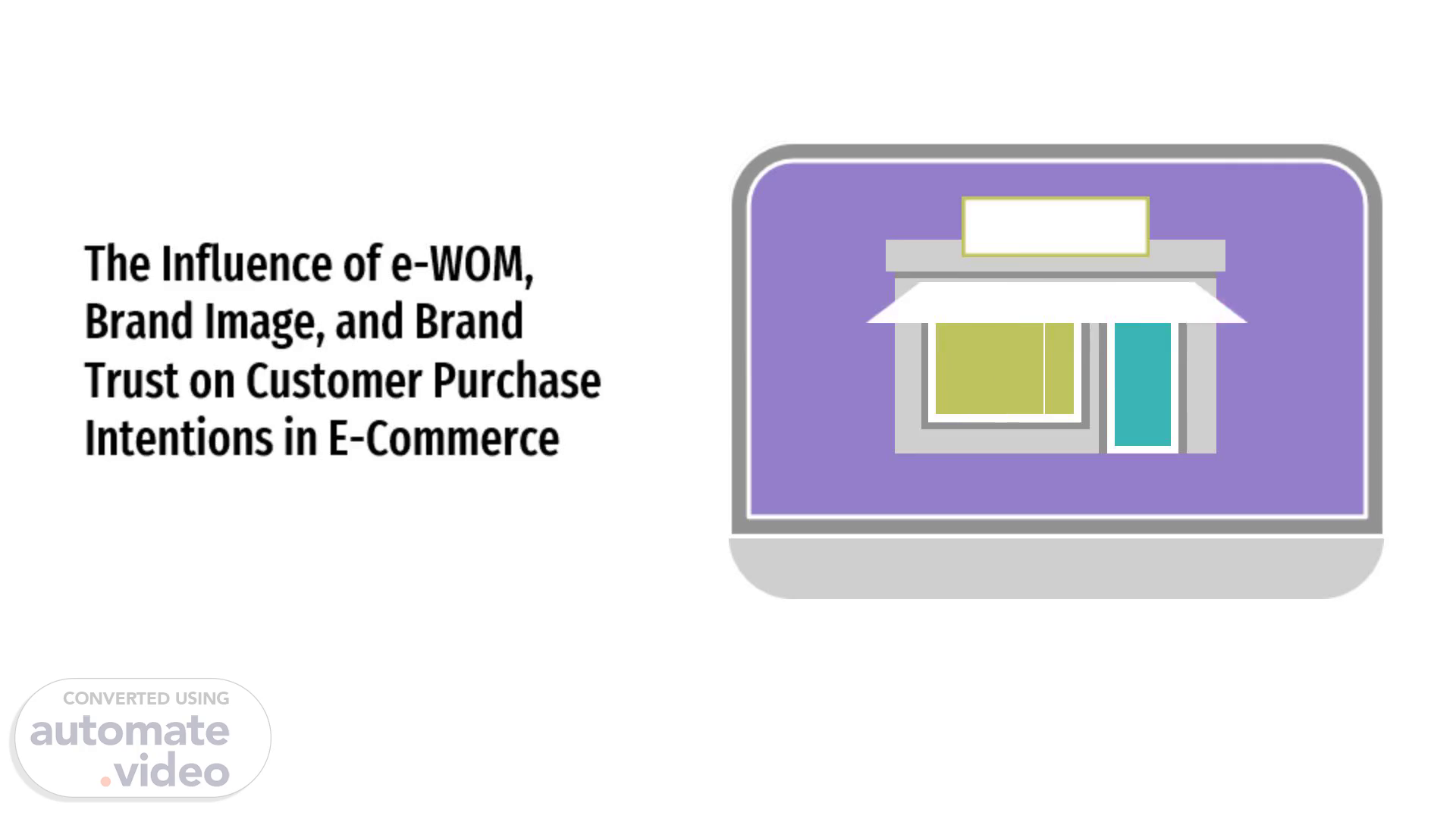Scene 1 (0s)
[Audio] Good morning, everyone. Today, I am pleased to present our research on the influence of electronic word-of-mouth, brand image, and brand trust on customer purchase intentions in e-commerce..
Scene 2 (17s)
[Audio] This study highlights key factors that drive consumer behavior in the online marketplace. As technology continues to evolve, the way we buy and sell products has changed dramatically. E-commerce has become a cornerstone of modern shopping, with convenience and accessibility driving its growth. In this context, electronic word-of-mouth has emerged as a powerful tool influencing consumer decisions. Consumers rely heavily on online reviews and recommendations to guide their purchases. Understanding the interplay between e-WOM, brand image, and brand trust is essential for businesses looking to succeed in the competitive e-commerce landscape..
Scene 3 (58s)
[Audio] The primary objectives of our research are to examine the impact of e-WOM on brand image and brand trust, determine how brand image and brand trust affect customer purchase intentions, and analyze the interconnected relationships among these variables in the context of e-commerce..
Scene 4 (1m 17s)
[Audio] Before we delve into our research methodology and findings, it is important to review the existing literature on these topics. Electronic word-of-mouth refers to customers or influencers sharing their opinions about products or brands online, and numerous studies highlight its impact on brand image and trust. Lin et al. (2023) and Sun et al. (2021) found that e-WOM positively affects brand image, while Siddiqui et al. (2021) and Kala & Chaubey (2018) observed that it generates a favorable brand image. Factors such as credibility and brand origin also play significant roles. e-WOM has been shown to enhance brand trust, with Sari et al. (2021) and Seo et al. (2020) noting a positive correlation between positive e-WOM and consumer trust. Handi et al. (2018) and Wiraandryana & Ardani (2021) further confirmed its significant effect on brand trust. e-WOM also positively influences purchase intention, as evidenced by Muniweera et al. (2020) and Tanprajna & Ellyawati (2020). Brand image, defined as a critical intangible asset by Martínez et al. (2014), significantly shapes consumer perceptions and influences purchase intention. A strong brand image fosters trust, which is further supported by Marliawati & Cahyaningdyah (2020), who assert that brand image exerts a positive and substantial influence on brand trust. Lastly, according to Tan et al. (2022) brand trust is essential for consumer loyalty and significantly impacts purchase intention. Understanding the interplay between e-WOM, brand image, and brand trust is crucial in the context of e-commerce, where these factors significantly influence consumer behavior..
Scene 5 (3m 26s)
[Audio] We collected data through a structured questionnaire survey distributed to 161 respondents who are active buyers on e-commerce platforms. After filtering, 153 responses were deemed usable for analysis. The survey was conducted between April 13 and May 5, 2023, capturing respondent demographics and buying habits to ensure a comprehensive understanding of the target group. The data were analyzed using Partial Least Squares (PLS) analysis with SmartPLS 4.0 software. The demographic profile of our respondents is as follows: 54% male and 46% female, 86% are aged between 18 and 25 years, 8% between 26 and 35 years, and 6% between 35 and 45 years. Additionally, 62% of respondents were from outside the Greater Jakarta area, while 38% were from within. This diverse sample provides a broad view of consumer behavior in the e-commerce space..
Scene 6 (4m 35s)
[Audio] Our study revealed several important findings. e-WOM positively influences both brand image and brand trust. Positive online reviews and consumer recommendations significantly shape how consumers perceive and trust a brand. Brand image positively influences both brand trust and purchase intention. A strong, positive brand image not only fosters trust but also encourages consumers to make purchases. Brand trust significantly affects purchase intention. When consumers trust a brand, they are more likely to proceed with a purchase. These findings highlight the critical role of e-WOM, brand image, and brand trust in driving purchase intentions in e-commerce..
Scene 7 (5m 19s)
[Audio] Our research contributes to theoretical knowledge by explaining the interactions between e-WOM, brand image, brand trust, and purchase intention, providing insights into the factors that drive consumer purchasing decisions in e-commerce, and enhancing the understanding of how e-WOM and brand image shape consumer perceptions and beliefs, thereby influencing purchase intentions. For practitioners, our findings offer actionable insights: Leverage e-WOM by encouraging positive online reviews and customer testimonials to enhance brand image and trust. Strengthen brand image by investing in consistent quality and effective marketing to build a strong, positive brand image that fosters trust and drives sales. Build brand trust by engaging in transparent communication and customer engagement to cultivate trust and confidence among consumers. These strategies can help e-commerce businesses enhance customer loyalty and increase sales..
Scene 8 (6m 23s)
[Audio] In conclusion, our research underscores the significant influence of e-WOM, brand image, and brand trust on purchase intentions in e-commerce. By understanding and leveraging these factors, businesses can develop effective marketing strategies to attract and retain customers in the competitive online marketplace. While our study provides valuable insights, it also highlights areas for future research. Future studies could explore additional variables that may influence purchase intentions in e-commerce, expand demographics to gain deeper insights into consumer behavior, and examine the impact of cultural factors and market dynamics on consumer perceptions and behavior. Further research in these areas can provide a more comprehensive understanding of the e-commerce landscape..
Scene 9 (7m 13s)
[Audio] Thank you for your attention. I am happy to answer any questions you may have..
